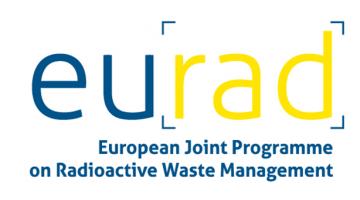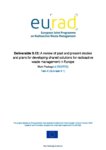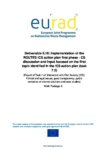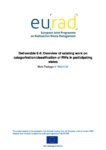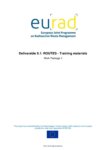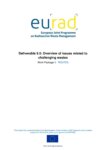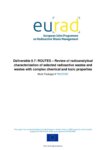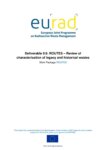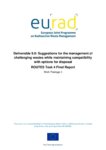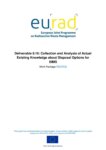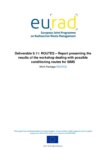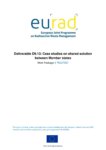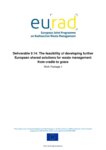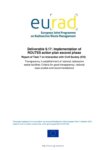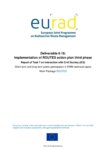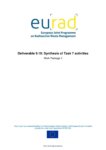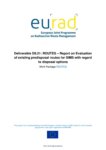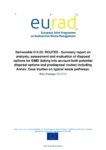ROUTES: Waste Management routes in Europe from cradle to grave (EURAD WP)
Project Dates: 1st June 2019 – 30 May 2024
Project Status: Finished
Project Website: https://www.ejp-eurad.eu/implementation/waste-management-routes-europe-cradle-grave-routes
ROUTES was a Strategic Studies Work Package (WP) within EURAD. It aimed to share experience and knowledge on radioactive waste management (RWM) routes between Waste Management Organisations (WMOS), Regulatory Technical Support Organisations (TSOs) and Research Entities (REs) from different countries, with programmes at different stages of development, with different amounts and types of radioactive waste to manage.
Overview
As noted under the EURAD Roadmap Theme 2 – “Radioactive waste characterisation, processing and storage (Pre-disposal activities), and source term understanding for disposal” – the pre-disposal activities including radioactive waste characterisation, treatment and conditioning, as well as storage, are considered as high priorities. Moreover, as highlighted in the Roadmap, a sufficient knowledge of the radionuclide and chemical content of the waste is a prerequisite for the development of the complete waste management route.
The common interests addressed in the ROUTES strategic studies were identified in the Roadmap and related to elements of Theme 2: Inventory collation and forecasting (3.5), the Methodology to define radionuclides inventories (3.6), understanding of the potential for long-term storage as a management option for disused sealed radioactive sources (3.10), the management of damaged waste packages and methods for reprocessing aged waste (1.2.4) and the waste acceptance criteria (2.1.6). All these subtopics are related to Roadmap Phase 0 (Policy, Framework & Programme Establishment), except the subtopic concerning WAC which is related to Phase 2 (Site Characterisation) and Phase 3 (Facility Construction).
Consequently, the raison d’être of this WP was to provide an opportunity to the organisations of the member states to share their experience and to identify common R&D interests associated with this topic. To this aim, safety-relevant issues and R&D needs associated with the waste management routes (cradle to grave) were identified, considering waste characterisation, the development of waste acceptance criteria (WAC) prior to the availability of disposal facilities, and options for disposal of small waste inventories. In addition to providing an overview of good practices for different steps in radioactive waste management and guidance for research activities, the work package provided an opportunity to consider sharing of technology and facilities.
Objective
This WP described and compared the different approaches to characterisation, treatment and conditioning and to long-term waste management routes between member states. The interested organisations were from different countries, with programmes at different stages of development, with different amounts and types of radioactive waste to manage. In this WP, safety-relevant issues and their R&D needs associated with waste management routes (from cradle to grave), including the management routes of legacy and historical waste, were identified. The WP considered past and present EU projects on the topics of interest and other initiatives carried out at international level such as IAEA and NEA so as to avoid duplicating existing work. The aim of this WP was to identify relevant R&D topics which could be collaboratively launched in the second wave of EURAD.
The ROUTES WP was organized into eight tasks to delve into the diverse challenges and potential solutions:
- Task 1: Coordination, state-of-the-art and training materials.
- Task 2: Identification of challenging wastes to be collaboratively tackled within EURAD.
- Task 3: Description and comparison of radioactive waste characterization approaches.
- Task 4: Identification of Waste Acceptance Criteria (WAC) used in EU Member-States for different disposal alternatives in order to inform development of WAC in countries without WAC disposal facilities.
- Task 5: Radioactive Waste Management (RWM) solutions for small amounts of wastes (focusing on disposal strategies for small-inventory Member-States).
- Task 6: Description of the state-of-the-art of shared solutions in European countries for characterization, treatment, storage and disposal and planned sharing of facilities between Member-States, as well as identification of gaps and R&D requirements.
- Task 7: Interactions with Civil Society.
- Task 8: ROUTES Extension on the evaluation of the possible waste management solutions for Member States without WAC and with small inventories (SIMS).
Task Outcomes
The Summer School on WAC for radioactive waste jointly organized by EURAD (WP 11 – Mobility and training) and PREDIS aimed at providing knowledge about fundamental aspects of WAC, its development, application, and explored instances of WAC integration within national programs was held. This training was targeting PhD students from the EURAD and PREDIS projects, as well as professionals working on WAC.
Helped to define what is meant by challenging waste, i.e., waste for which there are no current or applicable solution for their safe management, including difficulties or the absence of at least one step in the waste lifecycle. Waste can also be considered challenging even when the site for disposal itself is missing. Based on this definition, 11 types of challenging waste have been identified by the Member States: sludges, spent ion exchange resins, organic waste, bituminized waste, graphite waste, decommissioning waste, disused sealed radioactive sources, Ra/Th/U bearing wastes, particular spent fuel, waste containing reactive metals and waste containing chemotoxic substances.
Based on this work, technical meetings about each challenging waste were held as part of Subtask 2.2 in order to gather feedback from the Member States to better understand their good practices, main difficulties, or implemented solutions. These technical discussions allowed for the collection of detailed descriptions of particular problems that need to be solved, as well as common gaps amongst Member States.
Task 3 consists of two subtasks, each disseminating its results in a dedicated deliverable. The subtasks of Task 3 are entitled as follows:
- Subtask 3.1 – Radioanalytical characterisation of radioactive waste and waste with complex/toxic properties.
- Subtask 3.2 – Characterisation and segregation of legacy waste.
Subtask 3.1:
The subtask:
- identifed characterisation techniques,
- Compared characterisation methods applied for the same waste in different countries,
- Analysed existing approaches and identification of knowledge gaps, and
- gave recommendations both for future research and development (R&D) tackling the identified knowledge gaps and for characterisation approaches for countries with non-developed waste management concepts.
Subtask 3.2:
A model for an integrated approach of radioactive waste management was developed, including the transitioning phase from legacy to regular radioactive waste, as well as the emphasis on the applicability of the individual management steps for small amounts of waste. This integrated approach for the management of legacy wastes includes the management steps retrieval, sampling, characterisation, treatment, and conditioning. The management of legacy waste comprises all steps from retrieval to conditioning
This subtask then focused on three steps: “Segregation”, “Sampling” and “Characterisation” of legacy wastes and only included generic information and guidelines on the other steps of the integrated approach for the management of legacy wastes. This was because for retrieval of legacy waste the situation varies highly depending on the initial situation. This includes the status and type of waste, but also the location and accessibility of the specific legacy waste. The limiting framework for treatment and conditioning of legacy waste are significantly depending on the legal boundary conditions in the respective countries, e.g., existence of WAC for interim storage or final disposal, which also hinder specific handling guidelines.
ROUTES Subtask 4.1 involved the production of an up-to-date overview per country on the use of WAC in Member States and some Associated Countries, focusing on the use of WAC as a management tool across the waste lifecycle.
The objective of ROUTES Subtask 4.2 was to offer a structured approach to support decision-taking of ‘no regret’ waste management measures, i.e., decisions that do not lead to problems later on:
With regard to characterisation:
- Waste characterisation is essential to understanding the inventory. The waste inventory informs all subsequent management steps and has a major influence on measures that could be applied for waste minimisation, materials recycling and reuse.
- Characterisation at the time of waste generation is essential to minimise the need for more extensive characterisation downstream, which is often more challenging.
- An adequate records management process to store, and facilitate reference to, waste characterisation data needs to be implemented at an early stage, and to endure throughout the waste lifecycle.
With regard to treatment:
- Where possible (and relevant), treatment techniques should be flexible, to enable adaptations to be made in response to the particular characteristics of individual waste streams or site specific constraints, thereby ensuring that processing criteria and WAC for storage and/or disposal of the resulting product can be met wherever a technique is applied.
With regard to conditioning:
- Whilst conditioning waste into a matrix increases the level of passive safety provided, it significantly reduces flexibility for further management (without reconditioning) and may require the design and operation of a disposal facility to be tailored around conditioned waste characteristics, rather than optimising the waste conditioning approach against disposal conditions. Careful consideration is therefore needed before deploying such an approach to a given waste when its disposal route, and associated requirements, are not yet known.
- It may be preferable to apply interim waste management measures that are more easily reversible, such as repackaging waste in new containers and/or transfer to new storage facilities to facilitate decommissioning of older facilities. However, this can result in increased costs over the full waste lifecycle.
- On the other hand, arguments in support of early conditioning into a matrix include the promotion of safe, standardised storage through conversion of raw waste to a passively safe form. Early conditioning into a matrix can also facilitate a period of extended storage prior to disposal, buying time for additional research to underpin safe disposal. However, such an approach could lead to reducing the political urgency for finding a permanent waste management solution.
- Generic WAC can enable waste packaging to progress in the absence of a disposal route. However, they are typically more constraining than site- or facility-specific WAC since they require conservative assumptions to be made about disposal conditions, which can place a more onerous burden on those responsible for waste treatment and conditioning.
With regard to storage:
- Storage conditions should be designed to promote package longevity, thereby reducing the risk that already conditioned waste packages will require reconditioning. Storage arrangements should also enable package performance to be checked through monitoring. If these aspects are difficult to ensure, it may be preferable to minimise the extent of treatment and conditioning conducted (whilst still ensuring that the waste can be stored safely).
With regard to disposal:
- Where disposal WAC are available, uncertainty shifts towards characterisation to determine compliance (or otherwise), and/or the selection and qualification of treatment and conditioning methods that will result in a disposable waste form.
- A dual-track disposal strategy (i.e., planning for a national repository and pursuing opportunities for a multinational shared facility in parallel), can help to keep options open and increase the likelihood of identifying a suitable disposal route. Choosing to follow such an approach would be a political decision (at a national level) and might not be considered feasible or desirable in all cases.
- Where a shared solution for disposal is pursued, international political consensus on the basis for implementing the shared solution is essential between all those countries consigning and receiving waste. This may strengthen a desire for harmonisation of waste management arrangements (potentially including WAC) across affected countries.
- Where disposal WAC are subject to change, such changes can be more easily accommodated by implementing flexible treatment and conditioning techniques coupled with in-depth waste characterisation.
With regard to WAC definition:
- Waste generators and treatment / conditioning facility operators should be involved in the process for defining WAC as early as possible, to minimise the potential for WAC being
impractical to implement. - The link between WAC and the safety assessment for a facility is of primary importance. However, the scope of WAC does not necessarily have to depend entirely on the safety
assessment of a facility. It can also be linked with wider principles for waste management, and supported by experience from waste operations. Regardless of their scope and the basis for their derivation, there must be a clear justification for how a suite of WAC has been developed and why each criterion is necessary. - The responsibilities of different stakeholders for defining and applying WAC and for checking compliance need to be clearly defined and actioned, to ensure that waste acceptance systems are fit for purpose and to build confidence in their use.
- WAC could provide a tool for confidence building amongst civil society, for example by:
− Using them to communicate factors that are important to the safety case.
− Inviting civil society to influence their scope (this might be done indirectly, via inputs to the wider strategy development for a facility).
− Utilising independent citizen science to check compliance against WAC. - There is widespread interest in harmonisation of WAC across Member States and Associated Countries, primarily focusing on harmonisation of the methodology for their definition. Adoption of common approaches to define the broad scope of WAC, combined with cross-checking the completeness of WAC through reference to other waste management programmes, could give confidence, including amongst civil society, that a suite of WAC is fit for purpose and applies ‘best practice’.
The objective of ROUTES Subtask 4.3 was to give recommendations for R&D and Strategic studies. Identified areas for further work were:
- Common analysis on disposal strategy for wastes that do not meet the WAC for existing or planned facilities,
- Comparison and standardisation of radionuclides (and their speciation) to account for in waste characterisation and WAC,
- Benchmarking exercises for the process of WAC development,
- Development of characterisation methods to determine compliance of particular wastes with WAC,
- Development of methodologies for representative sampling of challenging waste types.
The generation of radioactive waste might be significantly different depending on the development status of a nuclear program. Even though the technical issues for Large Inventory Member States (LIMS) and Small Inventory Member States (SIMS) are often similar, boundary conditions to consider for radioactive waste management may be completely different.
Four challenging waste types relevant for SIMS were identified: Spent ion exchange resins (SIERs), disused sealed radioactive sources (DSRS), metals and concrete from decommissioning. Disposal options for these waste types were analysed and assessed qualitatively in the frame of the workshops, with the aim of providing a basis for future comparison with regards to the applicability of four disposal options for managing small amounts of waste: i) “on-surface option”, consisting in a long term storage followed by clearance, ii) near surface disposal, iii) geological disposal and iv) borehole disposal. Based on the “NDA Value Framework” methodology, the analysis of these disposal options
included major factors such as the effects on the environment, risk/hazard reduction, health & safety, security, socio-economic impacts, lifetime cost, as well as the facilitation of the mission. Additionally, the achievability of the disposal route was discussed, along with potential factors impacting its feasibility, required facilities for the implementation, as well as other relevant information or comments. A special focus was given to the applicability of the disposal routes for SIMS and the availability of shared solutions.
Usual advantages and drawbacks of the disposal options considered have been highlighted during this analysis:
- The on-surface option (long term storage followed by clearance) is feasible if only short lived (SL) nuclides are present in the waste. This option might lead to radiological discharges, as well as to an exposure of workers during storage. An advantage is the easy retrievability of the waste. Climate change can have an impact on the safety of the waste, as containers or buildings can degenerate faster. In addition, there are no intrinsic security measures, and this option can have a psychological impact on the public. The costs are low for construction but might be high for maintenance over long periods.
- Near surface disposal should only be considered if the amount of long lived (LL) nuclides in the waste is small. This disposal option can have an impact on the environment and public due to nuisance during construction. It offers higher security compared to on surface facilities and the exposure of workers will be lower than for on surface options as waste will be emplaced in disposal vaults. Climate change and its consequences must be considered, as well as costs that are higher than for on surface options. The visual impact on the neighbourhood is lower, but the psychological effects can be higher.
- Geological disposal has an impact on the environment from excavation, is energy intensive and has a high CO2 output. The safety is increased, and security enhanced. The costs are higher compared to the first options. The advantage is that in this type of facility all radioactive waste types can be disposed of. Geological disposal might be of interest for intruders if resources were mined at the facility in former times, and the resources become of interest again.
- Borehole disposal has less impact on public and workers than the other options. The exposure is low due to short operational times. The security is enhanced and quick closure possible. The costs are low, as standard drilling equipment can be used. However, this option is only applicable for small amounts of waste and is only suitable for DSRS amongst the waste forms studied within Subtask 8.2.
In addition, this analysis has allowed to highlight specificities regarding the different disposal options to the studied waste forms:
- Concrete from decommissioning could be used as stabilization or backfill material for other waste types.
- The on surface option (long term storage followed by clearance or export) is a valuable option for DSRS, that must be sent back to the producer since 2018.
- Near surface disposal is an available technology for DSRS. There is a risk of Rn-222 leakage from Ra-226 sources, as well as H-3.
- On surface options (long term storage followed by clearance) and borehole disposal have a limited suitability for SIERs due to the waste volume, depending on the selected predisposal route.
- Regarding the disposal of SIERs, near surface disposal facilities may implement a fixation of the waste in a matrix.
- Regarding on surface disposal, attention must be given to non-radiological hazards, such as from heavy metals.
- The hydrogen explosion risk that might occur in challenging wastes needs to be mitigated when considering the disposal of metals for decommissioning in near surface disposal facilities.
A particular interest emerged in the potential sharing of mobile treatment and characterization facilities, particularly for addressing challenges related to the characterization and treatment of sludges and resins. Representative sampling was also identified as a significant obstacle for successful waste characterization. Small inventory member states (SIMS) indicated resource constraints, notably to implement the characterization of their radioactive waste for decommissioning, due to the need for heavy infrastructures and specific skills. Consequently, the possibility of setting up an R&D programme on radiological characterization equipment that can be shared and transported between countries was discussed. This leads to the recommendation to develop a mobile facility for radioactive waste characterization, treatment or conditioning.
Even though several topics of common interest and suitable for shared solutions were identified, practical bottlenecks were also recognized: standard procedures, common waste classification, common understanding to WACs and harmonized regulations, were highlighted as topics which needed further development to achieve effective shared solutions. It is notably evident that sharing predisposal and disposal facilities needs important work in regulatory and Waste Management (WM) procedures harmonization. While technical research is needed, the advancement of shared solutions relies heavily on political decisions.
In this societal-political context, it is important to keep in mind civil society (CS) Task input to achieve a level playing field for the collaborators and lessons learned from case studies showing the importance of public consultation. This consideration leads to the recommendation to “harmonize procedures to facilitate collaboration between member states”, aiming at clarifying the complexities associated with determining the necessary procedures and permits, which can be both time-consuming and resource-intensive. Simplifying this process requires harmonizing the various steps needed to enhance the possibility of operating commercial treatment facilities outside national borders, help reducing storage periods and improve safety of workers, environment, and population, and encourage the possibility of using shared storage or disposal facilities through harmonized procedures.
The interaction with civil society in ROUTES was organised in Task 7, which is composed of CS experts working on topics of interest, investigated in other tasks. The Task 7 members are divided in teams who follow the activities in other tasks and contribute to the deliverables through webinars, and workshops and by commenting the results obtained the other tasks. In addition, the CS larger group has been involved in workshops discussing the results and obtaining feedback on proposed Task 7 drafts.
In total, Task 7 members authored five deliverables, which all focused on transparency and public participation in RWM through different lenses: first developed the methodology43 and scoping the tasks, and one deliverable devoted to shared RWM solutions, conditions for governance and issues of transparency and public participation; one dedicated to transparency in establishment of national radioactive waste facilities with proposals for criteria, and with practical cases and recommendations; and one addressing issues of transparency in the technical topics and long term governance of RWM.
The Task 7 team also contributed to the recommendations44 for future activities aimed at translating scientific and technical findings on effective interaction with civil society and highlighting the need for a strong implementation of the Aarhus Convention and maintenance of safety culture over multiple generations. In fact, those recommendations, listed in this deliverable (4.2), are suggesting various improvements for T&PP starting with propositions for international organisations like IAEA and OECDNEA or for EU member states in compliance with the Aarhus Convention Compliance Committee (ACCC) and the legislation. More specifically, some recommendations are given for regulators and authorities with concerns for the continuity of a sustaining and even improving CS engagement in the long-term in terms of skills and awareness.
The dissemination of the results has been widespread and diverse, including presentations at conferences and other events, organisation of webinars and inclusion of topics in round tables with, among others, the European Commission.
The interaction with civil society in ROUTES, demonstrated that such an approach is effective and serves several purposes: the CS experts can define their own methods and ways of working, which are then agreed upon with all ROUTES board members; the interactions with activities in the other tasks in ROUTES are productive and sufficiently detailed; thus, the overall contributions from Task 7 in events and analyses are well received. CS involvement in ROUTES is recognised also by other ROUTES members and broader as successful approach with big added value.
To sum up, the way that topics have been addressed in ROUTES by inclusion of CS could have a broader appeal and travel beyond EURAD, potentially serving as a model for transparency and public participation in other large-scale research projects, both within the EU and globally.
Closing words from WP Leader
The two main objectives in year 5 (finalization of ROUTES deliverables and dissemination of results) were achieved, thanks to the significant effort made by all board members. Notably, the final deliverable D9.3 reports all ROUTES recommendations, and special attention was given to disseminating information about the ROUTES project at various conferences, such as ICEM in October, the IAEA Conference on the Safety of Radioactive Waste in November 2023, and the WM Conference in February 2024. The ROUTES final meeting was attended by representatives from the IAEA and DG-ENER.

